Click on images to enlarge
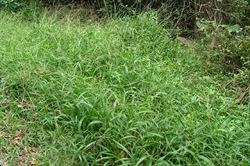
dense infestation (Photo: Sheldon Navie)

low-growing habit (Photo: Sheldon Navie)
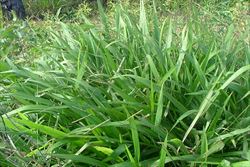
habit growing in a sunny position (Photo: Sheldon Navie)

habit growing in a shady position (Photo: Sheldon Navie)
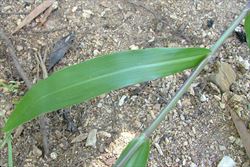
stem and broad leaf blade (Photo: Sheldon Navie)
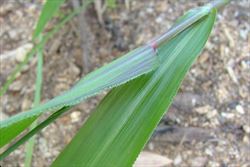
close-up of the base of leaf blades (Photo: Sheldon Navie)
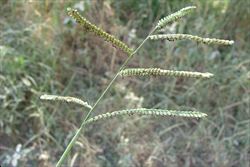
seed-head (Photo: Sheldon Navie)

flower spikelets densely arranged in four rows on the seed-head branches (Photo: Sheldon Navie)

close-up of flower spikelets with feathery stigmas (Photo: Sheldon Navie)
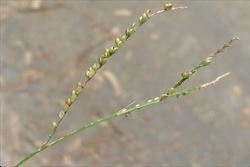
mature flower spikelets (Photo: Sheldon Navie)

seedlings and young plants (Photo: Sheldon Navie)
Scientific Name
Paspalum mandiocanum Trin.
Synonyms
Paspalum wettsteinii Hack. (misapplied)
Family
Gramineae (South Australia)Poaceae (Queensland, New South Wales, the ACT, Victoria, Tasmania, Western Australia and the Northern Territory)
Common Names
broad leaf paspalum, broad leafed paspalum, broad leaved paspalum, broad-leaf paspalum, broadleaf paspalum, broad-leaved paspalum, paspalum, warrel grass
Origin
Native to southern South America (i.e. southern Brazil, Argentina, Paraguay and Uruguay).
Cultivation
Broad-leaved paspalum (Paspalum mandiocanum) has been cultivated as a pasture grass and has been proposed as a potential groundcover for sub-tropical orchards.
Naturalised Distribution
This species is quickly becoming widely naturalised in eastern Australia. It is present in south-eastern, central and northern Queensland and in the coastal districts of northern and central New South Wales. Also naturalised on Lord Howe Island.
Habitat
A weed of roadsides, waste areas, disturbed sites, pastures, riparian areas and moist forests in wetter tropical, sub-tropical and warmer temperate regions.
Habit
A tufted long-lived (i.e. perennial) grass growing to 1 m tall, but usually less than 50 cm in height.
Distinguishing Features
- a short-lived or long-lived tufted grass growing to 1 m tall.
- its flowering stems are usually spreading or low-growing with upright tips.
- its leaves are somewhat glossy and relatively broad (8-20 mm wide).
- its seed-heads are composed of 3-10 branches, with a tuft of hairs at the base of each branch.
- the numerous flower spikelets (2-2.3 mm long) are arranged in four rows along the seed-head branches.
Stems and Leaves
The flowering stems (i.e. culms) are usually spreading or low-growing with upright tips (i.e. they are decumbent). These stems (45-125 cm long) are hairless (i.e. glabrous) and may sometimes produce roots at the lower joints (i.e. nodes).
The leaves consist of a leaf sheath, which partially encloses the stem, and a spreading leaf blade. The leaf sheaths are somewhat hairy (i.e. pubescent), particularly near where they join to the leaf blade, and the leaf blades are either hairless (i.e. glabrous) or somewhat hairy (i.e. pubescent). The elongated (i.e. lanceolate) leaf blades (10-30 cm long and 8-20 mm wide) have entire margins and pointed tips (i.e. acute apices). Where the leaf sheath meets the leaf blade there is a small membranous structure (i.e. ligule) about 1 mm long.
Flowers and Fruit
The seed-heads (3-12 cm long) are borne at the tips of the stems and are composed of 3-10 branches (i.e. the inflorescence is a panicle of racemes). Each of these branches (2-10 cm long) has a tuft of hairs at its base and numerous flower spikelets that are arranged in four rows. The flower spikelets (2-2.3 mm long and about 1.5 mm wide) are oval in shape (i.e. elliptic) and are mostly hairless (i.e. glabrous). They consist of a single bract (i.e. glume) and two tiny flowers (i.e. florets), one of which is only partially developed and does not produce a seed (i.e. it is sterile). The fully-developed (i.e. fertile) floret has two floral bracts (i.e. a lemma and palea), three stamens and an ovary topped with a two-branched stigma.
Reproduction and Dispersal
This species reproduces by seed. These seeds are probably spread by water, animals and in contaminated agricultural produce (e.g. fodder).
Environmental Impact
Broad-leaved paspalum (Paspalum mandiocanum) is regarded as an environmental weed in Queensland and New South Wales. This species grows in a wide range of conditions, from full sun to shaded sites, and suppresses or kills grasses and other species in the ground layer of vegetation. Because it grows well in heavy shade under a dense tree canopy, and is particularly invasive in wetter forest and rainforest communities.
This species was first highlighted as a potential weed in northern Queensland in 2002, where it was quickly becoming a serious pasture weed in the Atherton Tableland region. However, broad-leaved paspalum (Paspalum mandiocanum) is currently of most concern in south-eastern Queensland, where it was recently ranked among the top 100 environmental weeds. It can often be found growing along waterways and in riparian vegetation in the Brisbane area and is becoming increasingly invasive throughout the Gold Coast and Sunshine Coast regions.
It appears on several local environmental weed lists in south-eastern Queensland (e.g. in Gold Coast City, Maroochy Shire, Redland Shire and Caboolture Shire) and has also been recorded from conservation areas on the Gold Coast (e.g. the Tugun Hill Conservation Area and the Clagiraba Conservation Area). It is most abundant in disturbed areas of moist forest on the Gold Coast, and it appears to be altering the ecology of those areas where it becomes established.
In New South Wales, broad-leaved paspalum (Paspalum mandiocanum) is currently most common in the north-east of the state but it is spreading further south to the Central Coast region. It appears on the North Coast environmental weed survey list, is listed as environmental weed in Byron Shire, and is regarded as a nuisance plant in Gosford City. Like is south-eastern Queensland, it is invading and dominating the groundcover layer of vegetation in full sun to shade, and is an emerging problem in coastal reserves. For example, broad-leaved paspalum (Paspalum mandiocanum) is dominating the understorey and inhibiting natural regeneration in paperbark wetland communities in the Belongil Wetlands at Byron Bay.
It is also seen as a potential threat to the survival of two endangered species in northern New South Wales, Floyd's grass (Alexfloydia repens) and the black grass-dart butterfly (Ocybadistes knightorum). The black grass-dart butterfly (Ocybadistes knightorum) only feeds on Floyd's grass (Alexfloydia repens), which is limited to several small patches and is threatened by coastal development and weeds, especially broad-leaf paspalum (Paspalum mandiocanum).
Other Impacts
This species is unpalatable to grazing livestock, as well as native and feral animals.
Legislation
Not declared or considered noxious by any state government authorities.
Similar Species
Broad-leaved paspalum (Paspalum mandiocanum) is similar to other closely-related grasses, including paspalum (Paspalum dilatatum), Bahia grass (Paspalum notatum), Vasey grass (Paspalum urvillei), scrobic (Paspalum scrobiculatum) and tussock paspalum (Paspalum quadrifarium). These species can be distinguished by the following differences:
- broad-leaved paspalum (Paspalum mandiocanum) is a low-growing grass (less than 1 m tall) with relatively broad leaves (up to 20 mm across). Its relatively small flower spikelets (2-2.5 mm long) do not have long silky hairs on their margins and its seed-heads usually have only 3-10 branches (i.e. racemes).
- paspalum (Paspalum dilatatum) is a moderately-sized grass (usually about 1 m tall) with relatively narrow leaves (up to 12 mm across). It has relatively large flower spikelets (3-4 mm long) with long silky hairs on their margins and its seed-heads usually only have 3-7 branches (i.e. racemes).
- Bahia grass (Paspalum notatum) is a low-growing grass (usually less than 60 cm tall) with relatively narrow leaves (up to 10 mm across). Its relatively large flower spikelets (2.75-4 mm long) do not have long silky hairs on their margins and its seed-heads usually have only two branches (i.e. racemes).
- Vasey grass (Paspalum urvillei) is a tall grass (1-2.5 m tall) with relatively narrow leaves (4-9 mm across). It has relatively small flower spikelets (2-3 mm long) with long silky hairs on their margins and its seed-heads usually have 10-20 branches (i.e. racemes).
- scrobic (Paspalum scrobiculatum) is a moderate-sized grass (usually 0.5-1.5 m tall) with relatively narrow leaves (3-12 mm across). Its relatively small flower spikelets (2-2.5 mm long) do not have long silky hairs on their margins and its seed-heads usually have only 2-7 branches (i.e. racemes).
- tussock paspalum (Paspalum quadrifarium) is a tall grass (1-2 m tall) with relatively narrow leaves (4-9 mm across). Its relatively small flower spikelets (2-3 mm long) do not have long silky hairs on their margins and its seed-heads usually have 15-25 branches (i.e. racemes).

